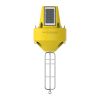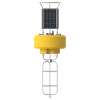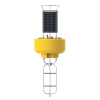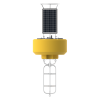NexSens CB-450 Data Buoy
Features
- Integrated 15-watt solar panels for 45-watts of solar charging
- Three 4" diameter sensor holes with female NPT threads for sensor deployment
- Topside plate supports solar marine light, weather stations, and other sensors
- Expedited repair and warranty service
- Lifetime technical support
- More
The NexSens CB-450 Data Buoy is designed for deployment in lakes, rivers, coastal waters, harbors, estuaries and other freshwater or marine environments. The floating platform supports both topside and subsurface environmental monitoring sensors including weather stations, wave sensors, thermistor strings, multi-parameter sondes, Doppler current profilers and other monitoring instruments.
The buoy is constructed of an inner core of cross-linked polyethylene foam with a tough polyurea skin. A topside 20” tall stainless steel tower includes three 15-watt 12VDC semi-flexible solar panels, and a center 10” ID x 19.5” tall instrument well accommodates batteries, data loggers, sensors, and more. Three 4” pass-through holes with female NPT bottom threads allow for quick connection of instrument deployment pipes and custom sensor mounts. The stainless steel frame supports both single point and multi-point moorings.
The CB-450 Data Buoy is optimized for use with NexSens X3 data loggers. Wireless telemetry options include global 4G LTE cellular, Iridium satellite, and global 4G LTE cellular with Iridium satellite fallback. Compatible digital sensor interfaces include RS-232, RS-485 and SDI-12. Each sensor port offers a UW receptacle connector with double O-ring seal for a reliable waterproof connection. For custom integrations, CB-PTL pass through and CB-MCL wet-mate data well lids are available.
- Hull Outer Diameter: 34.0” (86.4cm)
- Hull Height: 20.0” (50.8cm)
- Data Well Inner Diameter: 10.3” (26.2cm)
- Data Well Height: 19.5" (49.5cm)
- Pass-Through Hole Diameter: 4.0" (10.2cm)
- Tower Height: 20.0” (50.80cm)
- Solar Panels: 3x 15-watts
- Weight: 130 lb (59kg)
- Net Buoyancy: 450 lb (204kg)
- Hull Material: Cross-linked polyethylene foam with polyurea coating & stainless steel deck
- Hardware Material: 316 stainless steel
- Mooring Attachments: 3x 3/4” eyenuts
- (1) CB-450 solar tower
- (1) CB-450 buoy hull
- (1) CAGE instrument cage
In The News
Regional Lake Monitoring in Maine: Community Funded Research and Protection
Lakes everywhere are threatened by climate change, harmful algal blooms , invasive species, and other environmental stressors. Local, regional, and federal agencies have stepped up in order to defend the environment and water resources. The Lakes Environmental Association (LEA) in Maine is one example of an organization dedicated to protecting local freshwater resources. Dr. Ben Peierls, LEA Research Director, explains the history of the nonprofit, "For more than 50 years, [LEA] has been working locally, statewide, and regionally, helping or interacting with people on lake water quality, watershed protection, conservation, education, invasive species, and other issues.
Read MoreClimate Change and Microplastics: Monitoring Lake Champlain
Most people go to Lake Champlain for its exceptional views and thrilling boating, but it’s also home to a wide variety of interesting aquatic research projects. From studying microplastics to thermal dynamics of the lake, Timothy Mihuc, director of the Lake Champlain Research Institute (LCRI) at the State University of New York at Plattsburgh (SUNY Plattsburgh), has spent his career studying aquatic ecosystems. As an aquatic biologist, he’s the main investigator on Lake Champlain’s research studies while also managing their grants, employees, and their hands-on buoy work. Over the years, LCRI has received a number of environmental grants that aid in its monitoring research.
Read MoreThin Ice: Year-Long Monitoring in Missouri Reservoirs
The value of multi-lake studies is well understood by international organizations like the Global Lake Ecological Observatory Network (GLEON) and the scientists who work tirelessly to provide data to the larger network. Rebecca North, an associate professor at the University of Missouri-Columbia , is one of many researchers involved in multi-lake research initiatives and conducting research locally in her home state. Having been born and raised on the shore of Lake Ontario, North grew up in a community that revolved around water. She also saw firsthand one of the worst water quality bodies of the world, the Bay of Quinte, decline throughout her lifetime.
Read More











































